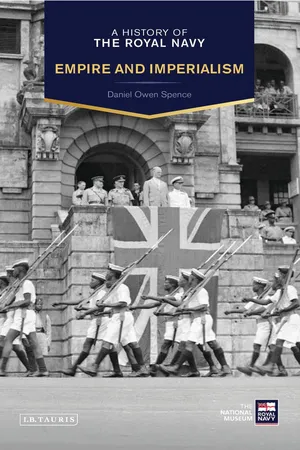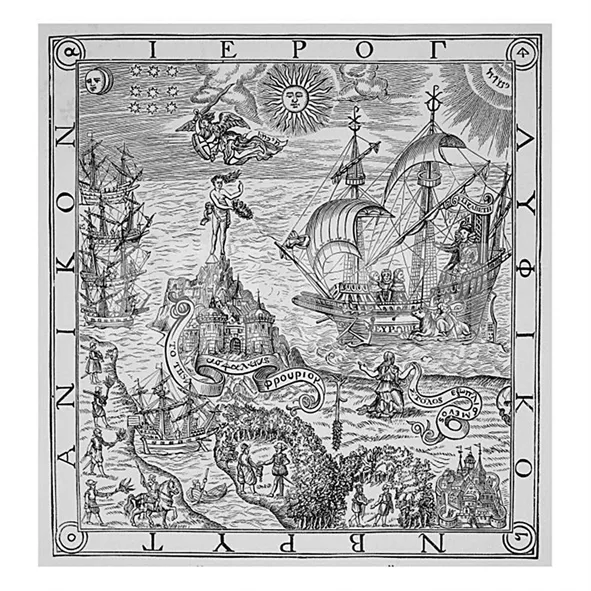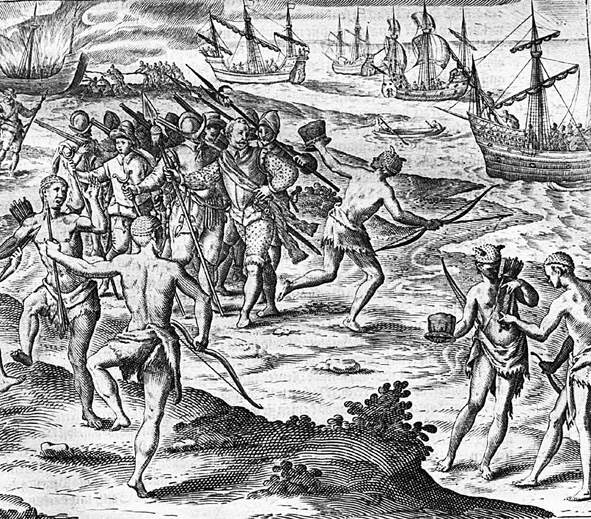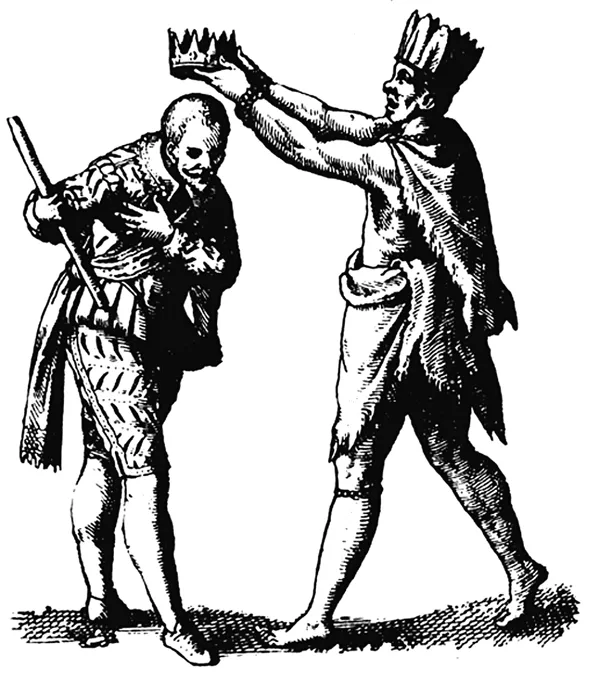Chapter 1
An Empire Emerges
Though the political entity of ‘Great Britain’ would not emerge until the 1707 Act of Union, the intellectual foundation of a ‘British Empire’, built upon a strong Royal Navy, developed over the preceding centuries. The royal courts of Tudor England brought together scholars, wealthy aristocrats, entrepreneurs and sailors who petitioned the monarchy to back colonial ventures in the ‘New World’ by providing a navy that could protect their interests against Spanish and Portuguese rivals. From these networks emerged chartered trading companies who relied upon the expertise of naval captains to lead their colonising expeditions. In the process, unknown lands were discovered and settled, creating new resources and markets for the English economy. State intervention to stave off foreign competition strengthened the navy by stimulating shipbuilding and training seamen, allowing it to seize additional colonies from rival nations in wartime. A symbiotic relationship developed between the Royal Navy and the empire, as trade needed naval protection, and warships required safe harbours to refit and resupply with colonial men and resources, leading to annexation for strategic as well as economic purposes. Yet imperial and naval power was psychological as well as physical, and indigenous encounters gave rise to racial ideologies which justified British authority over indigenous peoples, both within the colonies and the ‘Senior Service’.
The fifteenth and sixteenth centuries
By the end of the Hundred Years’ War, England’s territories on the European mainland had been reduced to just the Pale of Calais. During 1436, following the siege of that city and with the English having fled Paris, the first English language political poem emerged. While the country’s aspirations for continental domination were dwindling, ‘The Libelle of Englyshe Polycye’, or ‘Little Book of English Policy’, was ‘exhortynge alle Englande to kepe the see enviroun’. It prophesised that as an island nation, England’s future prosperity would depend on it acquiring and maintaining overseas colonies, particularly Ireland, for which strength at sea would be crucial: ‘wyth alle your myghte take hede / To kepe Yrelond, that it be not loste’. Though unappreciated at the time, ‘The Libel’ marked the beginning of a naval intellectual tradition within English political debate, inspiring the writings of prominent navalists over succeeding centuries, such as Richard Hakluyt and Samuel Pepys, and used as recently as 2012 to emphasise the ongoing importance of naval power to Britain’s national and foreign policy.1
While Henry VII (having turned Columbus down) backed John Cabot’s transatlantic voyages which gave England its historic claim to Newfoundland, it was during the reign of his son Henry VIII that the monarchy began to take a serious interest in the country’s navy. In 1511, the year the Mary Rose was launched at Portsmouth, his councillors argued that England’s maritime geography demonstrated that it was God’s will that the country should expand across the Atlantic Ocean and establish colonies in the New World, as Spain had done to its profit:
Let us in God’s name leave off our attempts against the terra firma. The natural situation of islands seems not to consort with conquests of that kind. England alone is a just Empire. Or, when we would enlarge ourselves, let it be that way we can, to which it seems the eternal Providence hath destines us, which is by sea.2
In 1577, the first recorded reference to a Royal Navy and ‘Brytish Impire’ appeared in John Dee’s General and Rare Memorials Pertayning to the Perfect Arte of Navigation. Dee was a notable mathematician, astronomer and occultist, and close advisor to Queen Elizabeth I. He was also a keen advocate for English imperial expansion, and used classical historians, medieval chroniclers, Renaissance cosmographers, Papal Bulls, genealogical charters and maps to press the Queen’s claim to ‘a great parte of the sea Coastes of Atlantis [otherwise called America] […] and of all the Iles nere unto the same […] and Chieflie all the Ilands Septentrionall [Greenland and Friesland]’. At the time that General and Rare Memorials was published, England found itself at the mercy of pirates, while foreign fishermen pilfered catches from her waters. In writing this book, Dee hoped to convince the Queen to create a ‘NAVY-ROYALL’ of ‘Three score Tall Ships, (or more)’ for the purpose not only of protecting the country from threats close to home, but to establish a British maritime empire:
I come to my chiefe purpose […] to stir upp your Majesties most noble hart, and to directe your Godlie conscience, to undertake this Brytish discover, and recovery Enterprise, in your owne Royall Interest: for the great good service of God, for your highness immortal fame, and the marvailous Wealth Publick of your Brytish Impire.3
This idea was graphically illustrated on the book’s woodcut title page. Elizabeth is depicted directing the ship of state towards the Roman goddess Fortuna, who is holding out a laurel wreath for the Queen. The wreath was synonymous with the great empire of the Romans, worn by its Caesars to represent their supreme imperial authority, and it was now being passed to Elizabeth. During the Middle Ages, Fortuna was associated with both a ship’s rudder, as she steered fate, and a cornucopia or horn of plenty, and thus her presence denotes that it is Elizabeth’s destiny to found a maritime empire for the nation’s prosperity. Britannia is seen kneeling on the shore and beseeching the Queen to build a ‘fully-equipped expeditionary force’ for that purpose. To her left is an ear of wheat, the promise of food abroad as the kingdom suffered from corn shortages, while also representing a Hermetic symbol for man. Its life-giving qualities are juxtaposed with the presence of a memento mori in the form of a skull to the right, where Elizabeth’s ship emerges. This warns of the death of England if the Queen does not follow her European rivals’ example by acquiring an overseas empire, the natural resources and the physical and spiritual nourishment that this offered the nation and its people. The presence of the archangel St Michael demonstrates that Elizabeth’s mission is sanctioned by God, ‘the HEAVENLY KING, for these many yeres last past, hath, by MANIFEST OCCASION’ made her his Protestant defender ‘of the most parte of Christendome’. She was thus charged with bringing light to the peoples of the New World, darkened by their indigenous ‘heathen’ practices and the heretical Catholicism of Spain and Portugal. This is visualised by the sun on St Michael’s shoulder, chasing away the dark night and moon. The nine stars in the sky might also symbolise the nine celestial spheres, as referred to in Dante’s Paradiso which recounts the soul’s ascension to heaven and the final sphere, ‘empyrean’, from whence the word ‘empire’ comes. Thus, in forging a British Empire with a Royal Navy, Elizabeth would get closer to God by creating a heaven on Earth.4
Fig. 1.1. Woodcut from Dee’s General and Rare Memorials Pertayning to the Perfect Arte of Navigation
Dee’s voice was not a solitary one at this time. The prominent London printer John Wolfe published a translation of the Dutch Protestant traveller Jan Huygen van Linschoten’s Discours of voyages into ye Easte and West Indies in 1598, which he dedicated to the ‘Judge of the High Court of the Admiralty’ in the hope that ‘you shall finde him any way beneficiall to our Countrey and Countrey men’. Its message was again an imperial one of religion and trade, promoting England’s ‘Honour over all ‘Countreys of the World’ and advancing
the Credite of the Realme’ by employing ‘our Wodden Walles […] in forraine partes […] for the dispersing and planting true Religion and Civill Conversation therein: as also for the benefite and commodity of this Land by exportation of such thinges wherein we doe abound, and importation of those Necessities whereof we stand in Neede.5
This intrinsic connection between the navy, commerce, empire and power was also emphasised by the famous naval commander Sir Walter Raleigh at the turn of the sixteenth century, when he wrote: ‘Whosoever commands the sea commands the trade; whosoever commands the trade of the world commands the riches of the world, and consequently the world itself’. Raleigh was a patron of Richard Hakluyt, who penned several important works arguing for English colonisation, including his Discourse of Western Planting, which he presented in 1584 to Queen Elizabeth in support of Raleigh’s scheme to establish an English colony in the New World. This marked a significant ideological break in that the Americas had previously been seen as a resource to be exploited and exhausted, in the privateering tradition, but Hakluyt conceptualised a much more modern form of settler colonialism, viewing it as a natural extension of England’s borders and population overseas.6
Hakluyt dedicated to Raleigh his 1584 translation of René Goulaine de Laudonnière’s L’Histoire notable de la Floride, in which he calls for England to follow ‘the course that both the Spaniards and Portugals tooke in the beginnings of their discoveries and conquestes’. His most famous work, The Principal Navigations, Voyages, Traffiques and Discoveries of the English Nation, furthered the idea of a maritime empire by demonstrating a long-running tradition of English nautical endeavour, lending legitimacy to territorial claims by its sailors who ‘in all former ages […] have bene men full of activity, stirrers abroad, and searches of remote parts of the world’. Nor were colonial horizons confined to the Atlantic, for according to the courtier and poet Philip Sidney, Hakluyt ‘hath served for a very good Trumpet’ supporting the colonial projects of Humphrey Gilbert, including his expeditions to discover a Northwest Passage. Such a route would encourage ‘commerce and traffike’ between England and Asia, as argued for in Hakluyt’s dedication to Francis Walsingham in The Principal Navigations’ 1589 edition. This relationship was considered mutually beneficial, for while the English would ‘use and exercise common trade with their marchants’, they would simultaneously spread ‘the incomparable treasure of the trueth of Christianity, and of the gospell’ to Asia. An Oxford Theologian, Hakluyt stressed this religious imperative for English imperial expansion in his translation of Pietro Martire’s De Orbe Nouo decades, again dedicated to Raleigh:
There yet remain for you new lands, very ample kingdoms, unknown peoples […] to be revealed, and by the good auspices of your arms and daring brought quickly and easily under the scepter of our serene highness Elizabeth, empress of the Ocean sea […] God will be with you, seeing that the glory is intended for God himself, for the salvation of infinite souls, and for the increase of the Christian republic […] nothing more glorious or deserving of honor can be passed to posterity than to tame the barbarians, to call back those who are in a natural state and pagan to the fellowship of civil life, to lead savage men back to within the orbit of reason, and to imbue atheists and others estranged from God with reverence for his divine will.7
Court intellectuals such as Dee, Wolfe and Hakluyt saw the creation of a maritime empire as more than an economic market for English imports and exports; it was also a divine and moral mission to ‘civilise’ and convert to Protestantism those less ‘enlightened’ parts of the globe. Such notions of a ‘civilising mission’ would continue to inspire British imperialists in the centuries that followed.
Fig. 1.2. Drake’s hat being stolen by ‘Indians’ near Rio de la Plata, c.1578
Several colonial ventures were attempted during this period, though they achieved little success. During his circumnavigation of the globe between 1577 and 1580, documented in The Principal Navigations, Francis Drake made landfall on the coast of northern California and claimed it for England as ‘Nova Albion’, but its geographic isolation made it impractical to settle. Humphrey Gilbert’s attempts to establish a colony in Newfoundland in 1583 ended with his ship’s sinking and his death. Of Raleigh’s colonial ventures in Virginia, the first, promoted by Hakluyt, was abandoned after just a year, while the second was disrupted by the Spanish Armada and its colonists’ unaccounted disappearance.
Fig. 1.3. The ‘Indians’ of California greet Drake
Both the navy and these early attempts at colonisation suffered from the absence of any sustained national maritime policy at this time. General and Rare Memorials reached some of the most influential privy councillors of the day, and many of Elizabeth’s key advisors shared Dee’s imperial vision theoretically. Yet his plans meant building the world’s largest navy – comprising six fleets and establishing provisioning ports across the globe – and were deemed too expensive at £200,000 per year. The Queen herself was criticised by her admirals for not fully appreciating the opportunities that sea power presented and the strategic value of capturing overseas bases like the Azores. Yet, with an annual income amounting to just an eighth of that available to King Philip II of Spain, and no long-term revenues to borrow against, both the Royal Navy and colonial entrepreneurs were reliant on private investment to stay afloat. This, and the privateering impulse of personal profit shared by sailors such as Raleigh and Essex and their financial backers, meant that their interests often diverged from those of the state, contributing to the failure of Drake’s 1589 expedition to La Curuña.8
The seventeenth century
It was during the early part of the seventeenth century that English colonisation of the New World really began to take root, with the organisation of private interests into chartered trading monopolies. A permanent settlement was finally founded by the Virginia Company in 1607 at Fort James (later Jamestown), with Hakluyt as one of its principal grantees. Whereas earlier efforts had failed largely because of their lack of logistical support, the Virginia Company utilised naval expertise to support its colonisation efforts. In 1609 it appointed Admiral Sir George Somers of the Royal Navy to command its Third Supply Fleet, but en-route to Virginia a storm separated his flagship, the Sea Venture, from the rest of the fleet, wrecking it on the island that would become Bermuda. Having salvaged materials to construct two new vessels, the Deliverance and Patience, Somers and his crew arrived in Jamestown ten months later to find the colony close to starvation. They returned to Bermuda for food, but during the journey Somers became ill ...



